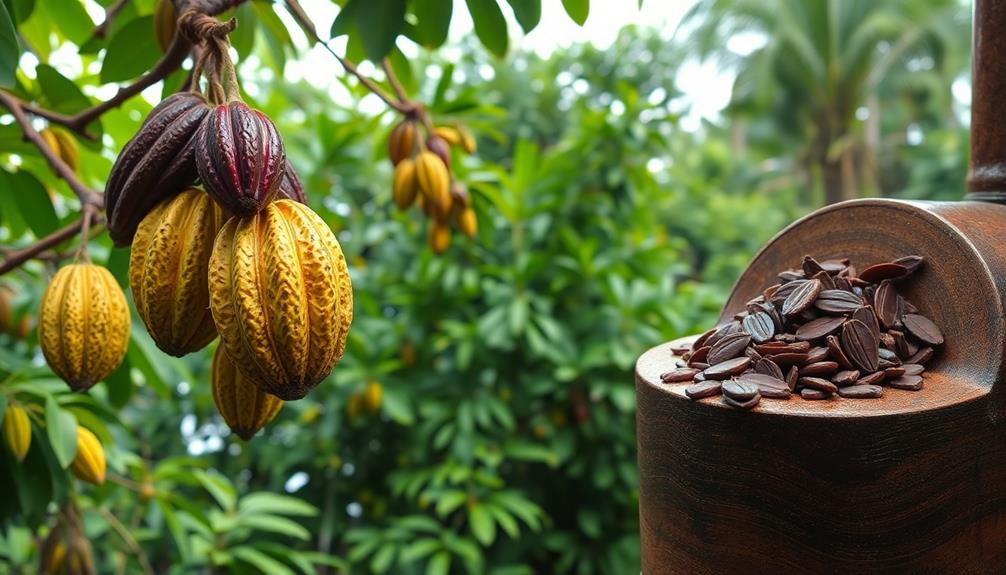Crafting perfect, crispy French fries at home is entirely achievable with the right techniques. Start by selecting starchy Russet potatoes for the ideal texture. After peeling and cutting them into uniform strips, soak the cut potatoes in cold water to draw out excess starch – this helps them cook up extra crispy. Thoroughly dry the potato strips before frying in batches at the proper temperatures to achieve that signature golden-brown color and satisfying crunch. Season the hot fries with salt, then serve and enjoy. With a bit of practice, you'll be whipping up restaurant-quality fries right in your own kitchen. For an irresistible pairing, consider serving your fries alongside a tried-and-true crispy fried chicken recipe for a complete comfort food experience. Both dishes require attention to technique and timing, but the results are well worth the effort. Mastering these staples will make your kitchen the go-to spot for indulgent homemade classics.
Key Takeaways
- Choose starchy Russet potatoes, cut into uniform 1/4-inch thick strips, and soak them in cold water for at least 30 minutes to remove excess starch.
- Thoroughly dry the potato strips using paper towels to ensure they cook crisp and don't stick together.
- Use the double-frying method, first at 325°F (163°C) for 5-7 minutes, then increase the temperature to 375°F (190°C) for 2-3 minutes for the best texture.
- Season the freshly fried fries immediately with salt to enhance the flavor.
- Serve the hot, crispy fries immediately for optimal texture and enjoyment.
History
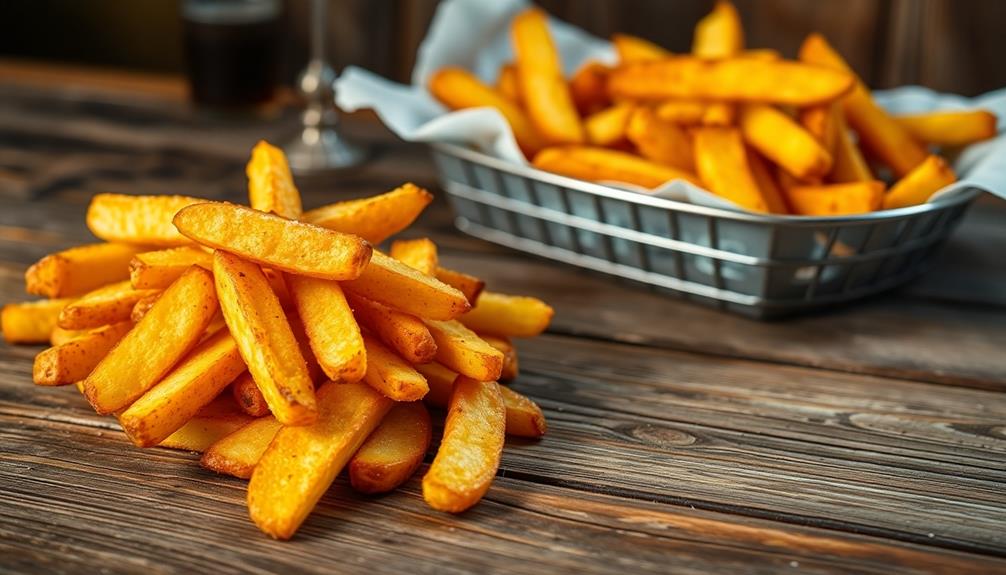
In the early 19th century, the French fry emerged as a beloved staple, captivating the palates of commoners and aristocrats alike. Though the exact origins remain debated, one popular theory suggests that French fries were first popularized in Belgium, where they were initially fried in animal fat.
However, the dish's iconic name can be traced back to its association with French cuisine, as the term "French fry" became widely adopted in the United States during the late 19th century.
As the industrial revolution took hold, the accessibility and affordability of potatoes made French fries a convenient and widely enjoyed food. Their crispy exterior and fluffy interior quickly gained them a devoted following, with the dish becoming a fixture at fairs, diners, and eventually, fast-food establishments.
Today, French fries remain a beloved comfort food, transcending cultural boundaries and delighting taste buds around the world.
Recipe
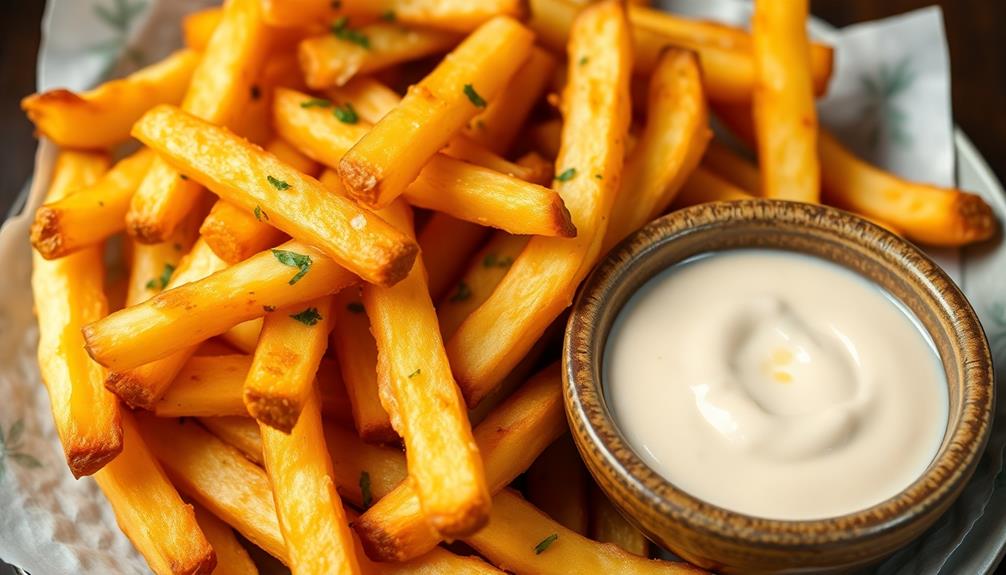
Perfect French Fries Recipe
Achieving the perfect French fries is an art form that requires attention to detail and a bit of technique. The key to delicious, crispy fries lies in the proper preparation and cooking process. This recipe will guide you through the steps to create the ultimate french fry experience in your own kitchen. For a refreshing treat after your fries, consider making some frozen yogurt pops – they're a great way to cool down during hot weather.
French fries are a beloved comfort food that can be enjoyed as a side dish or a satisfying snack. When done right, they should have a golden-brown exterior with a fluffy, tender interior. This recipe will provide you with the necessary knowledge to master the art of French fry perfection.
Ingredients:
- 2 pounds Russet potatoes, peeled and cut into 1/4-inch thick fries
- Vegetable oil for frying
- Salt
Instructions:
Rinse the cut potatoes in cold water to remove excess starch. Pat them dry thoroughly with paper towels or a clean kitchen towel.
Heat at least 3 inches of vegetable oil in a heavy-bottomed pot or Dutch oven to 325°F. Fry the potatoes in batches for 5-7 minutes, or until they're tender but not browned. Remove the fries from the oil and let them cool completely.
Increase the oil temperature to 375°F and fry the potatoes again in batches for 2-3 minutes, or until they're golden brown and crispy. Drain the fries on a paper towel-lined plate and season with salt immediately.
Tips:
For the crispiest results, be sure to double-fry the potatoes. The first fry at a lower temperature cooks the interior, while the second fry at a higher temperature crisps up the exterior.
Choosing the right potato variety, such as Russet, is also crucial, as they've a higher starch content that helps achieve the perfect texture. Proper drying of the potato fries before frying is essential to prevent splattering and ensure a crispy finish.
Cooking Steps
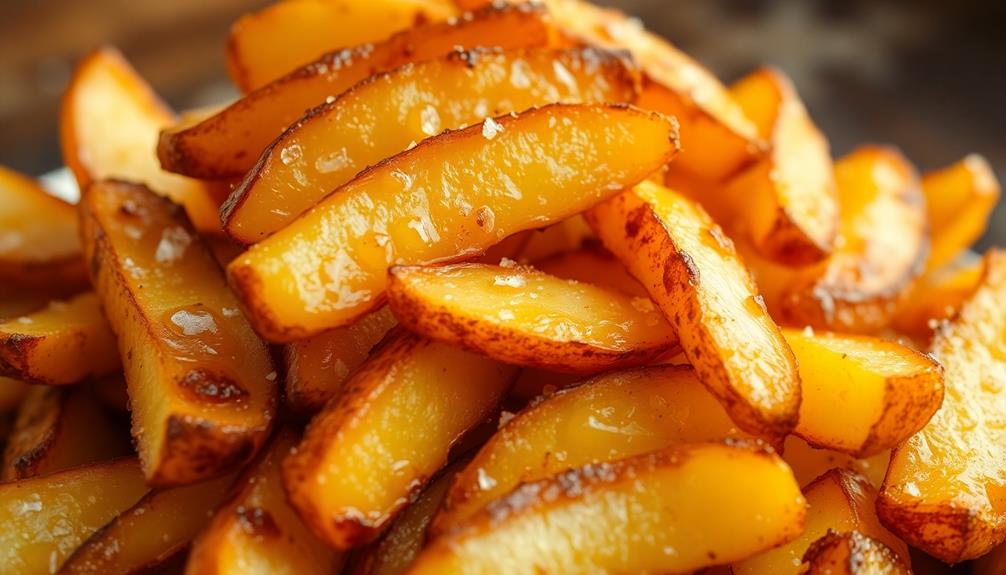
Peel and cut those potatoes into long, thin strips to get the perfect french fry shape.
Soak the potato strips in cold water to remove excess starch, then dry them thoroughly with paper towels or a clean kitchen towel.
When you're ready, fry the potato strips in batches at the right temperature to achieve that golden-brown crispness, and don't forget to season them with a sprinkle of salt.
Step 1. Peel and Cut Potatoes Into Strips

Gather your potatoes and a sharp knife. Peel the potatoes, removing any imperfections or eyes. Once peeled, rinse the potatoes under cold water to remove any excess starch. Pat them dry thoroughly with paper towels or a clean kitchen towel.
Next, slice the potatoes into long, even strips about 1/4-inch thick. For best results, use a sharp knife or a mandoline slicer to ensure uniform thickness. This will help the fries cook evenly.
As you cut, try to keep the potato strips as straight as possible. If they're too thin, they may become overly crispy, while thicker strips could become undercooked. Aim for a consistent, medium-thickness cut.
Place the potato strips in a bowl of cold water to prevent them from browning while you prepare the rest. This step keeps the potatoes fresh and helps remove some of the excess starch, resulting in a crispier texture when cooked. Once the rest of your ingredients are ready, drain and pat the potato strips dry before proceeding with your easy baked potato recipe. This ensures they bake evenly, creating a deliciously tender interior and golden, crispy edges.
When ready to cook, drain the potatoes and pat them dry again using paper towels or a clean kitchen towel.
Step 2. Soak Potato Strips in Cold Water

Soaking the cut potato strips in cold water is a crucial step that helps remove excess starch and prevents them from browning. This process is essential for achieving the perfect French fry texture – crispy on the outside and fluffy on the inside.
After slicing the potatoes, submerge the strips in a large bowl or container filled with cold water. The water should completely cover the potatoes. Let them soak for at least 30 minutes, or up to 2 hours if you have the time. This allows the starch to be drawn out, resulting in fries that are less likely to stick together and will cook up beautifully crisp.
When you're ready to fry, drain the potato strips and pat them dry thoroughly with paper towels or a clean kitchen towel. This step ensures the potatoes will sizzle and brown when they hit the hot oil, rather than steaming.
With the excess starch removed and the potatoes dried, you're one step closer to French fry perfection.
Step 3. Dry Potato Strips Thoroughly
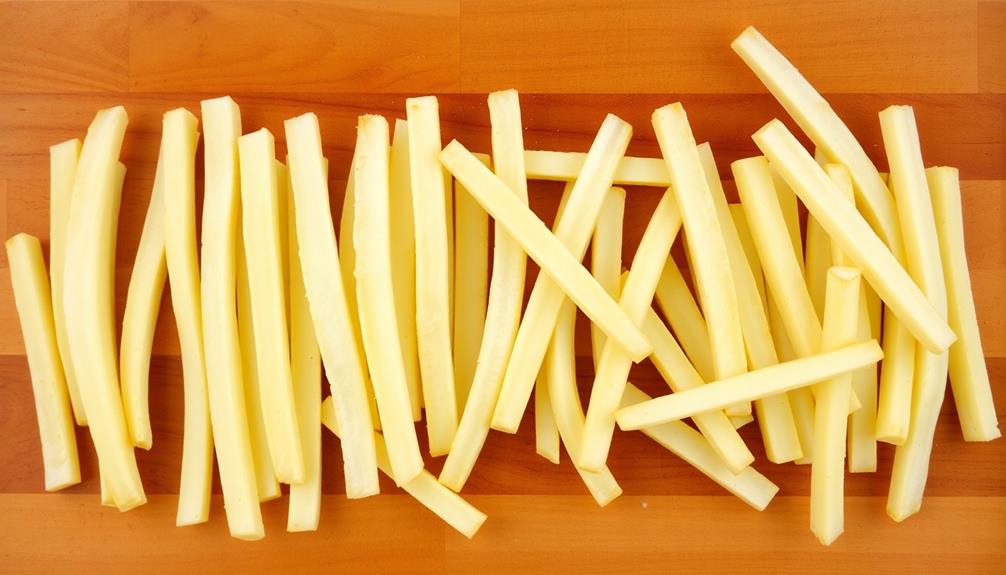
After draining the soaked potato strips, it's crucial to pat them dry thoroughly. This step is essential for achieving the perfect crispy texture. Use a clean kitchen towel or paper towels to gently dab and press the potato strips, removing as much excess moisture as possible.
Don't rub or squeeze the potatoes, as this can damage their shape and surface. The drier the potatoes, the better they'll fry, resulting in a golden-brown exterior and fluffy interior.
Once the potato strips are thoroughly patted dry, arrange them in a single layer on a clean, dry surface, such as a baking sheet lined with paper towels. This allows any remaining moisture to evaporate, further preparing the potatoes for the next step.
Ensuring the potato strips are bone-dry is crucial for achieving the perfect french fry texture. With this step complete, you're well on your way to creating delicious, crispy homemade french fries.
Step 4. Fry Potato Strips in Batches
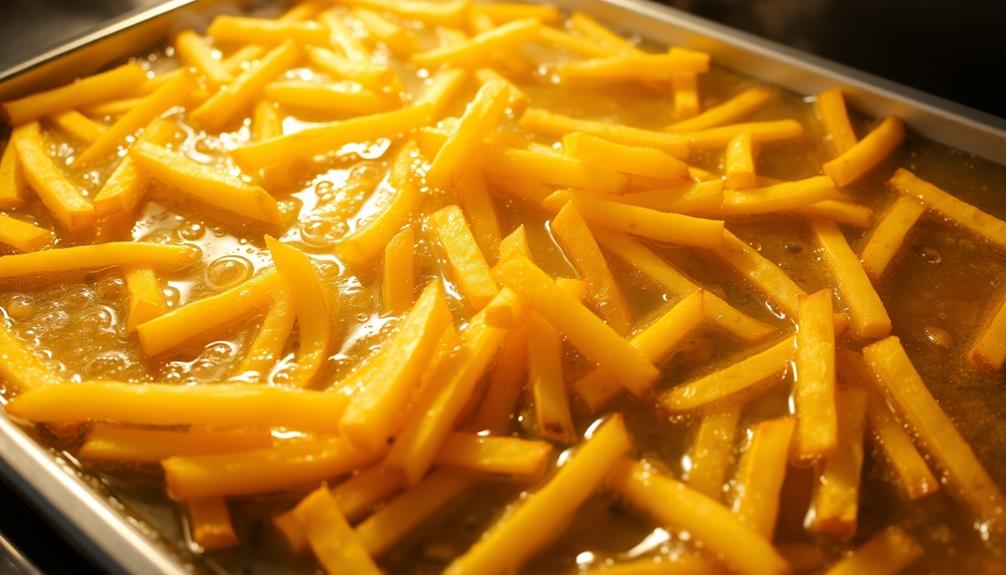
With the potato strips thoroughly dried, it's time to start frying.
Grab a large, heavy-bottomed pot or Dutch oven and fill it with 2-3 inches of high-heat oil, such as peanut or vegetable oil. Heat the oil to 325°F, using a deep-fry or candy thermometer to monitor the temperature.
Once the oil is ready, carefully add a handful of potato strips, making sure not to overcrowd the pot. Fry the potato strips for 5-7 minutes, or until they're golden brown and crispy.
Using a slotted spoon or tongs, transfer the cooked fries to a paper towel-lined plate to drain excess oil.
Repeat this process, frying the potato strips in small batches, until all the fries are cooked.
Be sure to maintain the oil temperature between 325-350°F throughout the frying process. This will ensure the fries cook evenly and develop that perfect crispy texture.
Step 5. Season With Salt
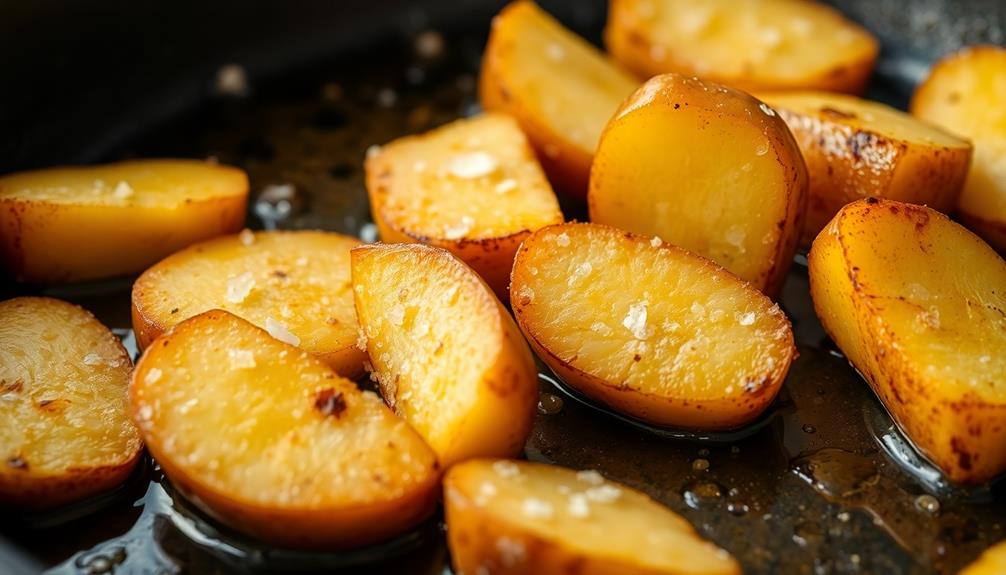
As soon as the fries have drained on the paper towel-lined plate, season them generously with salt. This is a crucial step in achieving the perfect french fry texture and flavor. The salt will help draw out the natural moisture from the potatoes, resulting in a crispy exterior and fluffy interior.
For the best seasoning, use a high-quality, coarse-grained sea salt or Kosher salt. These varieties have a more pronounced flavor and will cling better to the hot, freshly fried potatoes. Sprinkle the salt evenly over the fries, making sure to cover all the nooks and crannies.
Don't be shy – you want to see a generous dusting of salt covering the entire batch. The salt won't only enhance the potato flavor but also act as a natural preservative, helping the fries stay crisp for longer.
Once seasoned, give the fries a gentle toss to distribute the salt evenly. Now they're ready to be enjoyed hot, straight from the fryer, or tucked into your favorite burger or sandwich.
Final Thoughts

Perfect French fries are the culmination of careful preparation, attention to detail, and a deep understanding of the science behind frying. As you've now mastered the art of selecting the right potatoes, properly cutting and soaking them, and frying them to golden perfection, you can take pride in your ability to create restaurant-quality fries at home.
While the process may seem daunting at first, with a little practice, you'll find that making perfect French fries is both satisfying and enjoyable.
Remember to adjust the frying temperature and duration based on your specific setup, and don't be afraid to experiment to find the technique that works best for you.
Ultimately, the joy of serving up a plate of crispy, fluffy fries, perfectly seasoned with salt, is what makes this recipe so rewarding.
Savor the moment, and feel confident in your newfound mastery of the humble-yet-delicious French fry.
Frequently Asked Questions
What Type of Potatoes Work Best for French Fries?
You'll get the best results for French fries using starchy potatoes like Russet or Yukon Gold. Their high starch content helps them crisp up beautifully when fried, creating that classic golden exterior and fluffy interior.
How Can I Make My Fries Extra Crispy?
To get extra crispy fries, soak the potato slices in cold water for at least 30 minutes to remove excess starch. Dry them thoroughly before frying in batches at a high temperature. Toss the hot fries with a pinch of salt.
How Long Can I Store Cooked French Fries?
You can store cooked french fries in the refrigerator for 3-4 days. Make sure to let them cool completely before storing in an airtight container. For longer storage, consider freezing the fries for up to 3 months.
Can I Use an Air Fryer to Make French Fries?
Absolutely! You can use an air fryer to make delicious french fries. It's a healthier alternative to deep frying, as it requires less oil. The air fryer can quickly and evenly cook the fries, giving them a crispy exterior.
What's the Best Way to Reheat Leftover Fries?
You can reheat leftover fries in the oven or air fryer. Spread them out on a baking sheet and bake at 400°F for 5-10 minutes, turning halfway, until crispy. The air fryer works well too, just reheat at 400°F for 2-3 minutes.


